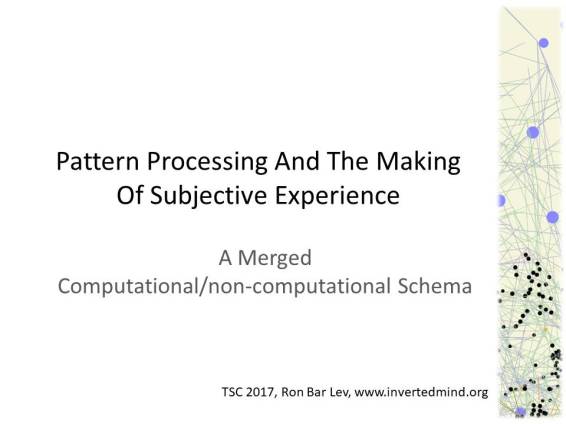
This presentation is not about the ontic nature of consciousness. What follows can be considered regardless of ontological inclination, bar an assumption that some pre-experiential qualities manifest in some vaguely defined microphysical order of scale (But not as ‘properties’ as in the philosophical tradition).

Regardless of whether one favours penrose’s QM based conjecture, or the Argentinian school’s Neuroelectrodynamics based ideas regarding causality, time dilation and interaction, or any other fundamental microphysical underpinning for consciousness,- The schema presented here could be applicable.
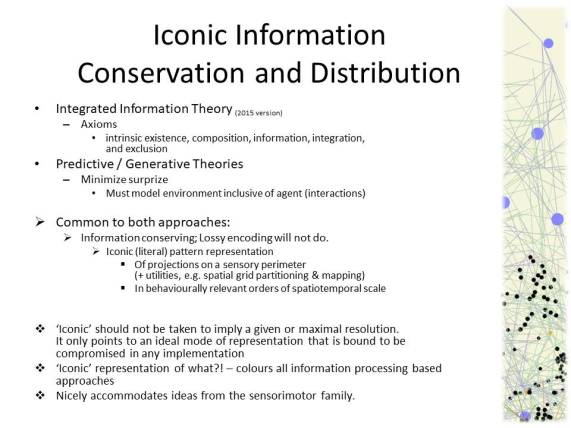
Contrary to it’s claims, IIT (2015 incarnation) sidesteps tackling the hard problem of consciousness, leaving the phenomenon in it’s axioms. But these axioms do indicate that the thinking there is based on some notion of fine-grained if not smooth combination of information and phenomenality.
Whether one adopts IIT’s axioms, the axioms which assume that consciousness exists, that experience is actual, compositional and maximally integrated (but not quite the information theoretical cause-effect postulates); or one prefers to scrutinize predictive/generative functional theories of cognition (e.g. Friston), which say nothing about experience (even as they emphasize minimization of surprise, in purely mathematical, information theoretical terms),- It seems obvious that any system exhibiting these characteristics must also try to be an information conserving system.
Lossy encoding, although probably necessary for function, cannot support the definitive requirements. What is strictly required is an iconic pattern tracing capability in behaviourally relevant orders of scale, of patterns projecting on an agent’s sensory perimeter. What is likely required is additional utility information constructs, such as environmental partitioning grids. What is suggested is information distribution (embedding, diffusion) throughout the system.
Any schema based upon a notion of iconic representation must be defended in the face of the immediate objections it provokes. Most obvious is the question regarding ‘iconic representation of what?’ in light of established physiological knowledge – Considering for example all the processing taking place in the retina, that compresses the visual sensory information 100 fold, into about a million uni-directional afferent axonal lines, then the various processing stations along the signal path, e.g. mapping and further compression at the LGN. At this stage let me just say that the difficulty is recognized, there is a reply, and that the defence is multi-faceted. Not part of the defence, but worthy of noting, is the fact that the same objections should apply to IIT, and to all generative proposals.
While the scope of the presentation extends only to aspects of perceptual processing, not mental manipulation, The theory nicely accommodates ideas from the sensorimotor theories of cognition, the notion of affordances (Noe, O’Reagen), both because of the sensory perimeter coupling of true to source iconic representations, as well as the defusion of information through the system, such that some information is only made available to the system (i.e. is enacted) through stimulation (affordances), regardless of overall representational capacity (the theory is neutral with regards to the analog effects of embodiment on agent interaction with it’s environment; these simply reduce the computational load).
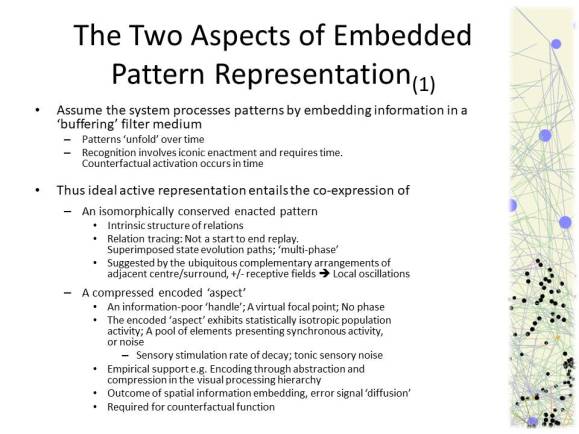
But of course the representation of conserved patterns is not a simple recording / playback mechanism. Embedding entails the translation of spatiotemporal relations to spatial ‘engrams’. The activation of an embedded representation implies an isomorphically true-to-source tracing of (spatiotemporally aligned) intra-pattern relations, in super-imposed state evolution paths (as constrained by the pattern). We apprehend ‘en-bloc’, not in linear fashion, but we can serialize to resurrect succession.
In pseudo maths terms: For any point in some representation of the pattern, the orders of derivatives in space and time are preserved, for multiple phases of the pattern at once, throughout the duration of the activation of the representation. Multiple phases of the pattern are superimposed; There is relation preserving smearing,- a balance between density and sparseness, in which complexity presents.
This is a key point in this presentation: That Relation preserving smearing may characterise conscious information representation.
Thus pattern representations exhibit two aspects: The first presents as multi-phase iconic playout of intrinsic relations, and the other presents as an information depleted, tending to isotropic activity virtual focal point. A convenient ‘handle’ for activation. A compressed encoding, an implementation likely presenting as simple periodic oscillations, or noise, throughout an active pool of units. Note that the pragmatic residual of information embedding in the medium would be travelling waves such as Freeman recorded 60 years ago, simple oscillations and, finally, noise.
This backdrop of residual excitation, plus slowly decaying post stimulation reverberation, as well as tonic noise in sensory receptors, may actually facilitate handle formation, and may also promote sensations arising from it’s existence (ref. slide 8).
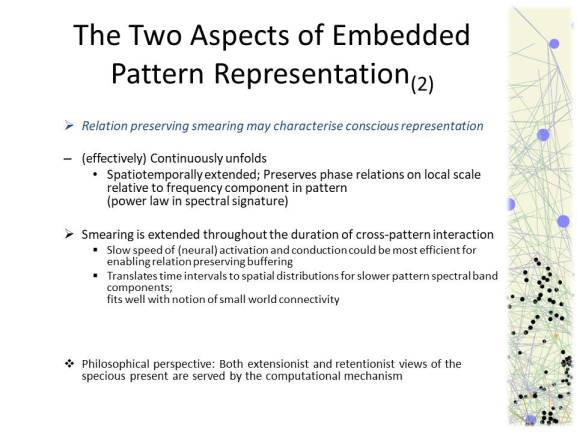
Furthermore, one can see that by this line of thinking an enacted pattern effectively continuously unfolds (skipping a discussion of the meaning of ‘effectively’ and whether it’s use is required here…), and that local phase relations in relevant orders of scale are preserved as it does so – implementations of which should yield a bandwidth-limited power-law spectral signature.
WRT to continuity – it may be said that the system modulates the gating of the woven pattern traces. Why am I experiencing my sensations rather than your sensations? Because of the system’s capacity to trace, amplify, smear and generate the effectively continuous representations that make ‘Me’.
Since in the world patterns are enacted and relation preserving smearing is applied in biologically behaviourally relevant timescales,- The frequencies of neural firing, the long time constants of neural integration, and the (slow) speed of conduction – may all have been tuned by evolution to efficiently support iconic relation preserving buffering.
It may also be worth noting that the idea that time intervals get translated into spatial distributions, fits well with the notion of small world connectivity in brains.
And a comment alluding to philosophical heritage: WRT sensation in time – the computational schema being described serves both extensionist and retentionist views of the specious present.
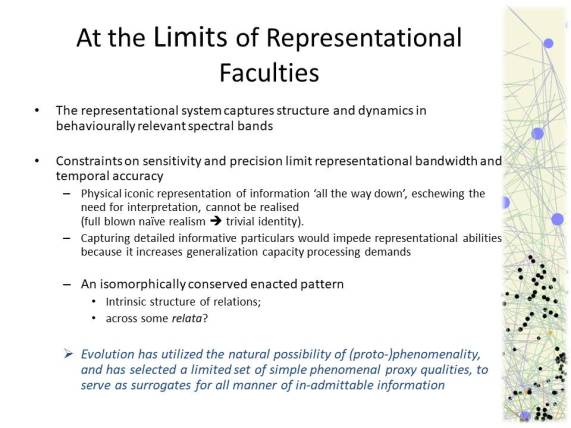
Perhaps the world is describable by physics ‘all the way down’, by physics known and physics yet to be formulated… But any representational system implementation is constrained by it’s limits of precision and sensitivity, to trace structure and dynamics spanning some orders of scale.
Especially close to, and at, the sensory interface between a representationally capable agent and it’s environment, the sensory gateway must reject, or at best locally embed, ‘fine grained’ information that requires precision and sensitivity that are beyond the limits of the system’s representational faculties.
Furthermore if the system were trying to capture details ‘all the way down to simples and particulars’ it would pay a penalty in overall processing and especially generalization capacity cost. E.g. if the texture of the wood making up the frame of a chair was to be perceived as molecules jumping about along a boundary, rather than conveniently lumped up into [hard, smooth, brown] close to the sensory interface, then obviously representation would have become much more demanding
Thus contrary to the drive to implement information conserving representations, the system turns to rely on generalizing shorthand surrogates, that stand in for fine grained information beyond it’s processing limits.
With some poetic license, such sub-patterns of rejected or lost information make up the ideal relata that would ‘lie on the edges’ of the patterned approximations traced by a representational implementation.
A tenet of the theory being presented is that evolution has utilized the natural possibility of (proto-)phenomenality, and has selected a limited set of simple phenomenal proxy qualities, to serve as surrogates for all manner of in-admittable information – That which is rejected on or close to the sensory perimeter, or that which is generated by the processing medium but is too fine-grained to be shared through communication.
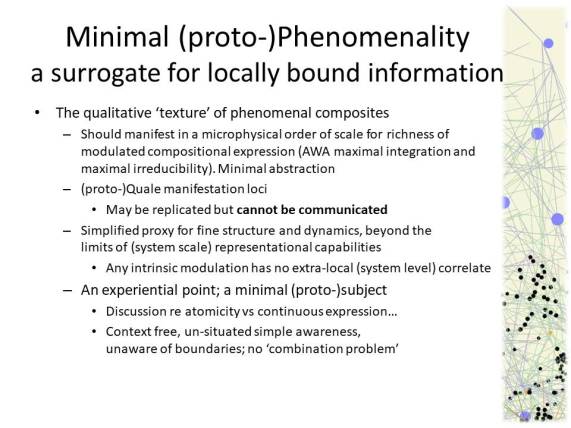
The proposal here is that Potential Minimal Awareness (sidestepping discussion of atomicity, property philosophy) stands in for fine-grained locus-bound information on some microphysical order of scale.
Although no particular ontology of (proto-)conscious precursors is flagged here, it is relevant to look at the case for microphysical manifestation. Some QM based claims wave a banner of non-locality. A parsimonious view would see such effects limited to small orders of scale. How far will an photon travel before it interacts with particles in it’s warm and wet vicinity? If one favours time-dilation based ideas – then on what order of scale would these manifest? In biological systems macromolecular hosted mechanisms are probably the largest units one should consider for playing a role in the awareness orchestra.
To complement this, regardless of whether it manifests as a result of some intrinsic or correlated tension, interaction upon a constraint, or some kind of particular simple, proto-awareness arising at the sensory detail level would support IIT’s requirements for maximal richness of modulated compositional expression, maximal integration and maximal irreducibility.
The minimal subject manifests at the limit of the most simple awareness – The fleeting putative proto-quale would posses no situational context nor harbour a sense of boundaries (thus avoiding the philosophical ‘combination problem’).
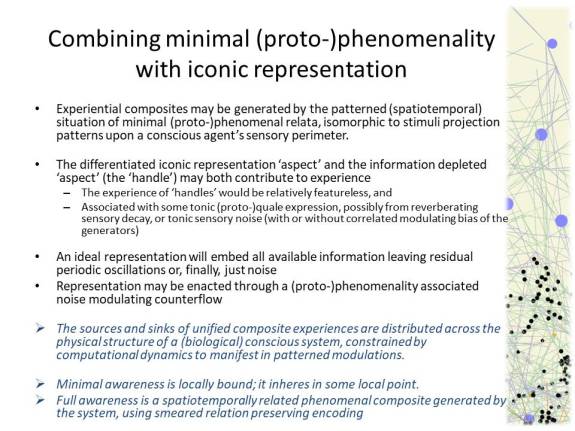
Experiential composites may be generated by the patterned (spatiotemporal) situation of minimal (proto-)phenomenal relata, whereby:
a. – the patterns are isomorphic to stimuli projection patterns upon a conscious agent’s sensory perimeter, plus some computational utilities, and
b. – The proto-phenomenal simples, are minimal locus-bound underpinnings of subjective awareness, that are related to each other by the literal iconic representation.
The sensing of relations is taken to be a corollary of the overlaid distribution and effectively continuous progression of experiential relata (i.e. a consciously perceived pattern is a ‘reverberating’ dynamic arrangement of minimal experiential particulars).
Every patterned experience has two ‘poles’: The differentiated iconic representation ‘aspect’ and an information poor ‘aspect’.
The relatively featureless virtual focal point aspect may be associated with the backdrop of encoding residuals, sparse un-encoded ambience, a slow rate sensory stimulation decay in receptors, or noisy sensory receptors, or some other relatively tonic pool of (proto-) phenomenality manifesting loci, or it may be generating a distinct modality of experiential expression (i.e. as amplified in a ‘thought’ quale).
Thus a combination of the relatively featureless virtual focal points of all the unstructured ‘handle’ aspects of the structured contents of full blown consciousness around a point in time, may be a partial source of the sense of a ‘raw I’, the subjective observer presence.
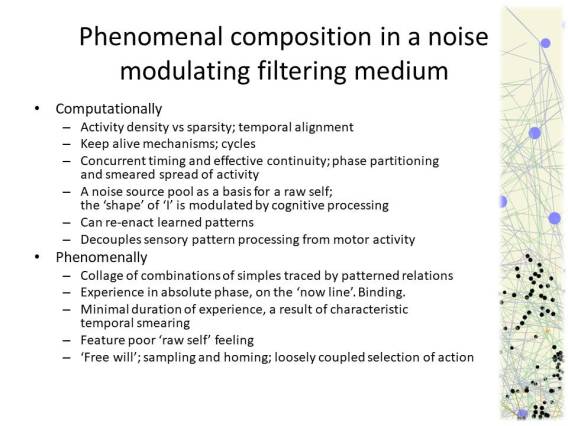
A remarkable feature that falls out of this theory is that well formed distinct phenomenal composites can arise naturally even as partitioned representations are co-enacted. The system does not strictly need to rely on deep running labelled lines for the conservation of distinct sensory qualities. For example – The ‘Cocktail problem’ is dissolved, and multiple modalities manifest in distinct dimensionality by definition.
Related to this, note that ‘Binding’ is part and parcel of the merged combination of the form of representation and minimal awareness that has been described, and that in this context the ‘unity of consciousness’ is a direct corollary of how pattern representation evolves in time, around the ‘now line’.
Note Also that the ‘shape’ of the information-poor virtual-focal-point postulated to be contributing to the sense of ‘raw I’ – the presence of a subjective observer, is not important because of it’s oscillating or stochastic tending-to-isotropic dynamic. It may be modulated (e.g. by attention shifts) without obvious sensing.
Finally, note that consistent with this proposed schema, since sensing does not require explicit coupling, and both sensation and information are distributed, the system may conduct a search by sampling it’s representational space, and can elect to ‘home in’ to converge on increasingly accurate representations as more information is integrated and becomes sensed, in loose analogy to an FM radio applying automatic frequency control. Note that this is but one characteristic of that which is commonly called ‘free will’.